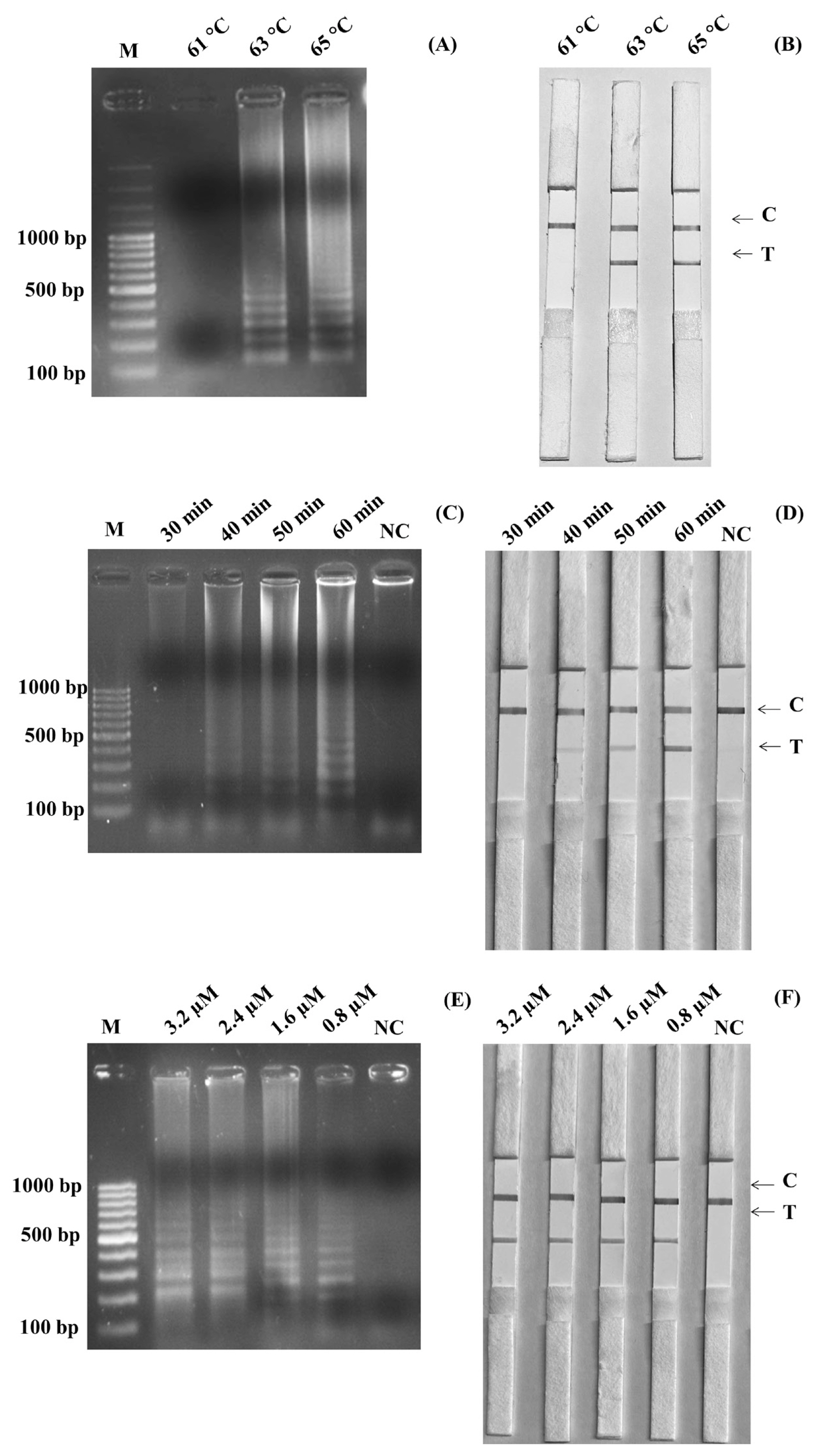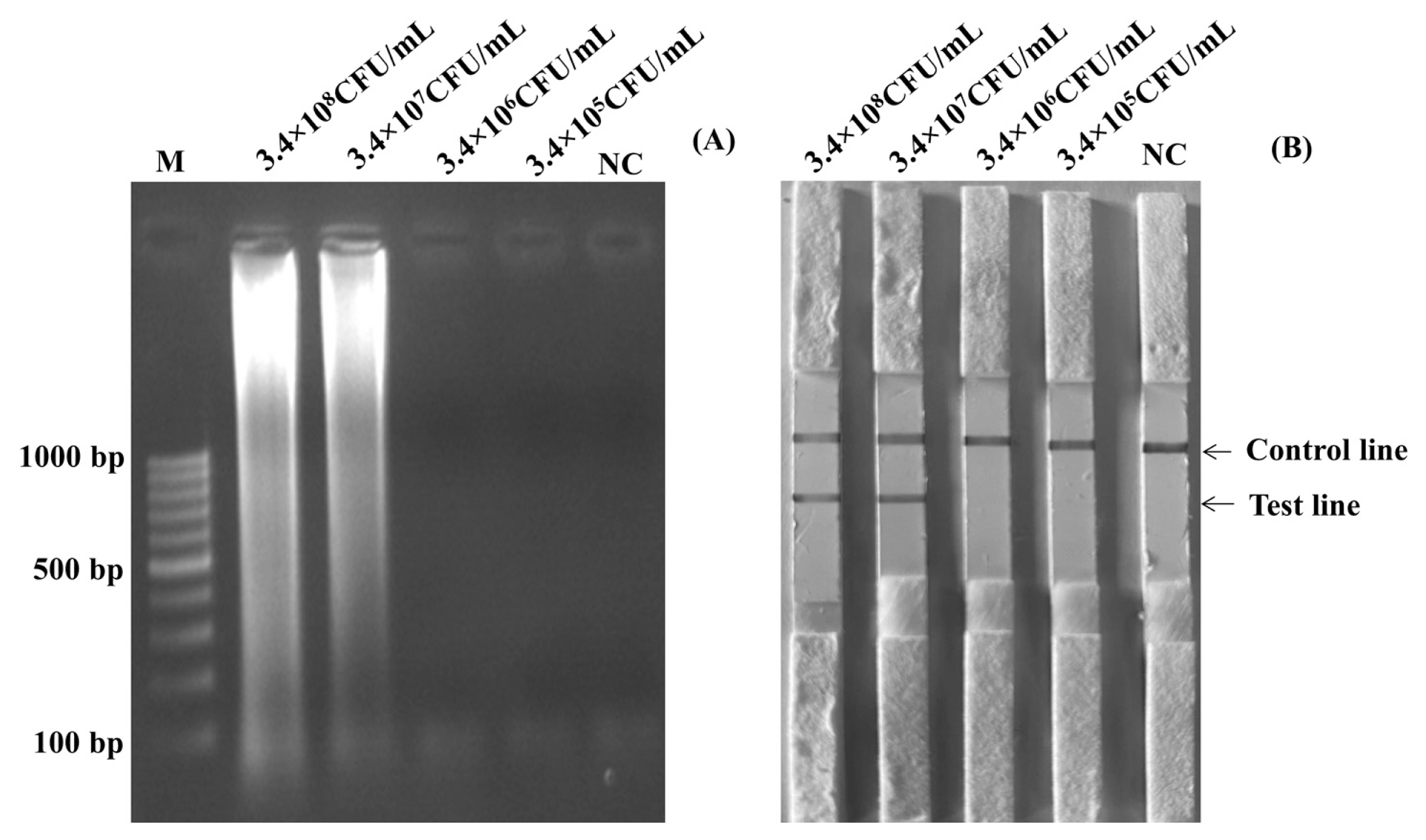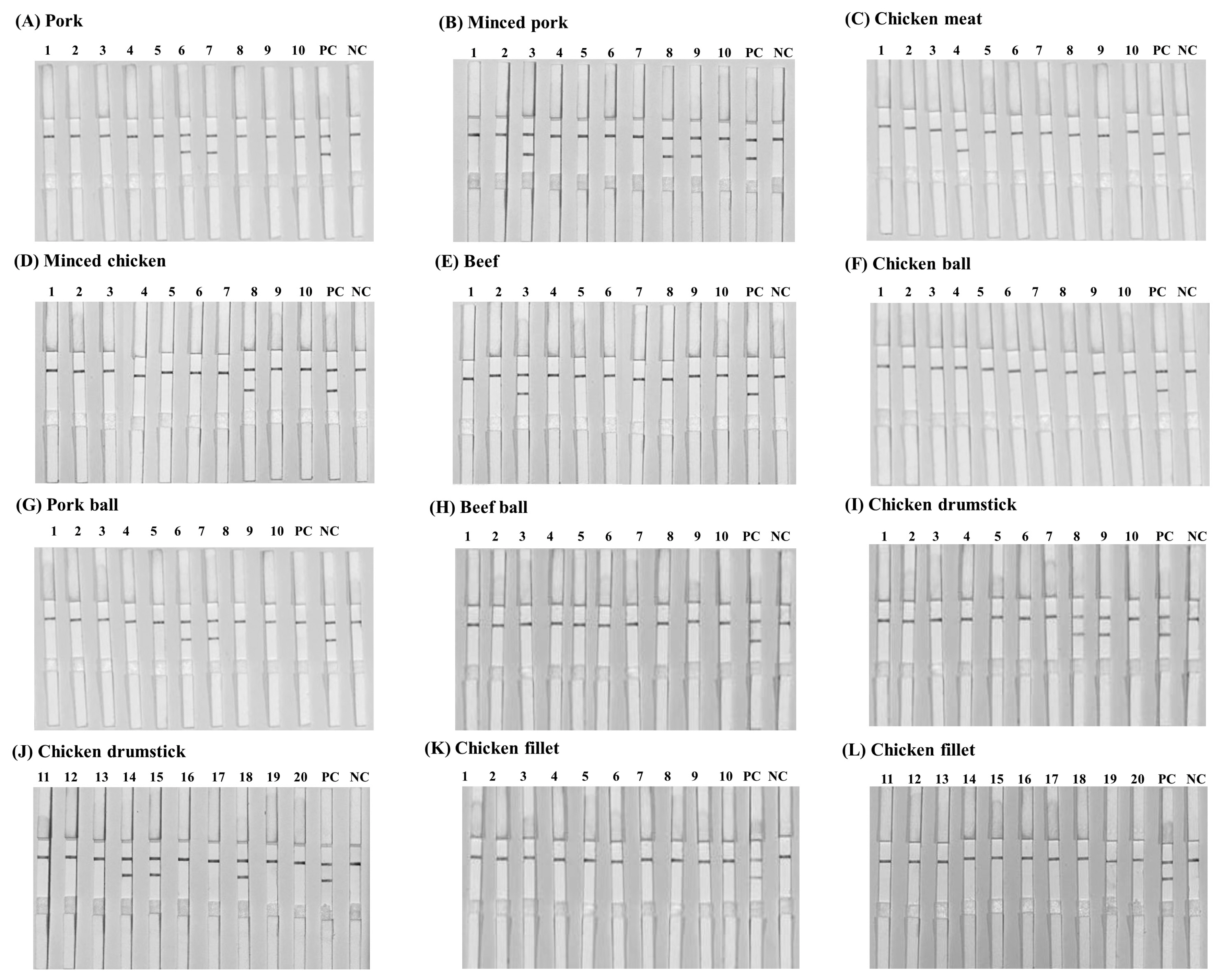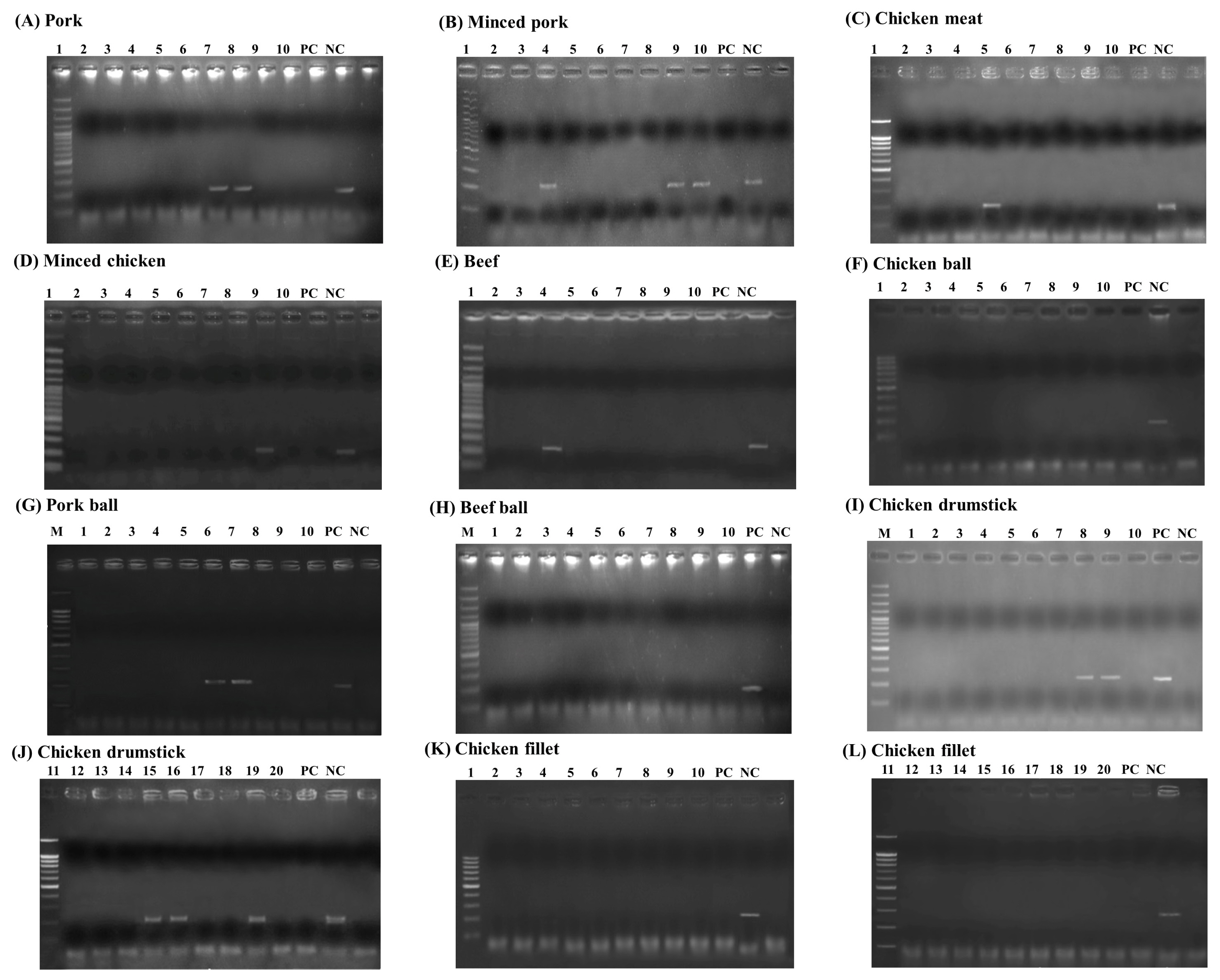INTRODUCTION
Foodborne pathogens cause a wide range of diseases with major consequences for human health and the economy. A foodborne disease outbreak occurs when two or more cases of a similar illness occur as a result of the consumption common food. The World Health Organization reported that, poisoned foods and water affect over 600 million people globally, resulting 4.2 million deaths per year [
1].
Salmonella is regarded as a serious public health problem, closely associated with food-borne illness outbreaks all around the world [
2]. According to the Centers for Disease Control and Prevention (CDC) reported the
Salmonella causes 1.35 million illnesses, 2.65 thousand hospitalizations with confirmed infections and 420 deaths occur in the United States each year [
3]. Salmonellosis is commonly spread by consuming food or water contaminated with sick animal feces. The infection can be transmitted by direct contact with infected animals or through the eating of animal-derived foods such as chicken, swine, fish, shellfish, and animal products [
4]. In order to maintain a safe food supply and lower
Salmonella infection levels in the future, it is necessary to monitor and test for the appearance of
Salmonella [
5].
The standard
Salmonella culture method for the detection and identification of
Salmonella in food samples relies upon bacteria growing in culture media such as pre-enrichment, selective enrichment, selective plating, biochemical testing, and serological testing. These procedures are reliable, simple, and inexpensive, but they take a few days [
6]. Molecular technology was developed to investigate food-borne pathogens such as
Salmonella in a variety of foods, especially with the advent and ongoing development of molecular diagnostic tools [
7]. The first commercially available polymerase chain reaction (PCR)-based molecular food detection technology was released in 1992. Other methods, including real-time PCR and multiplexing, became accessible in the years following.
Since 2000, a new generation of amplification techniques based on loop-mediated isothermal amplification, or LAMP, has been created by Japanese researcher Prof. Tsugunori Notomi and colleagues as a popular tool for pathogen inquiry [
8]. LAMP is based on the activity of the
Bst DNA polymerase enzyme, which may produce a particular strand of nucleotide and 4 to 6 strands of primers that can bind to specific target genes at up to 6 sites at 60┬░C to 65┬░C. As a result, a highly specialized LAMP product was created. LAMP is becoming increasingly popular since it does not require expensive equipment such as a thermal cycler or PCR machine [
9]. LAMP products can be determined using a variety of techniques, involving turbidimeters, fluorescent agents, gel electrophoresis, and the lateral flow dipstick (LFD) immune-chromatographic assay [
10]. The LFD test is a simple diagnostic method for confirming whether a target sample exists or not, such as diseases or biomarkers in humans or animals, or contaminants in water, food, or animal feeds. The most well-known type of lateral flow rapid test strip is the pregnancy test [
11]. The LFD assay is able to detect DIG-conjugated LAMP products that were formerly hybridized with a DNA probe labeled with Biotin. Hybridized LAMP products and anti-Biotin antibody with a gold label on the conjugated pad of the LFD can form signal or color complexes on the test line. As non-target products were unable to form complexes, no signal or color could be detected [
12]. This study aimed to develop LAMP combined with LFD to compare with LAMP-AGE, PCR, and standard
Salmonella culture as reference methods for detecting
Salmonella contamination in animal products and animal production environmental samples.
DISCUSSION
The
InvA gene is the most commonly utilized and successful gene for generating LAMP primers to detect
Salmonella [
12]. LAMP was originally presented for
Salmonella detection in 2005. Later, modified
Salmonella diagnosis methods based on various target genes were developed, such as
stn,
hilA,
bcfD, and
fimY [
13]. LAMP products have been detected using a variety of approaches. The LFD assay provides good SP testing and visual result evaluation [
12,
16]. In the previous study, the researchers developed the LAMP technique in conjunction with the LFD technique to examine and report the results. In this study, the LAMP technique in combination with the LFD technique (LAMP-LFD) was selected based on the
InvA gene and achieved the best primer set from previous studies (Masphol et al [
13]). A modified LAMP product analysis protocol from gel electrophoresis and the addition of SYBR Green I to the LFD for detecting
Salmonella spp. Also, new probe was designed to target the
InvA. labeled DIG-with FIP primers and Biotin-labeled DNA probe, primer set and DNA probe labeled was used for the LAMP technique in conjunction with the LFD technique (LAMP-LFD) and focused on the LAMP-LFD technique to examine
Salmonella contamination compared to other methods such as LAMP-AGE, PCR, and culture methods. For LAMP-LFD, a reaction temperature of 63┬░C for 60 min and an increased probe concentration of 0.8 ╬╝M within the LAMP reaction are required. Hybridization of the probe is used in most of the studies that follow the LAMP reaction [
1,
5]. Probes were hybridized along with the LAMP method, which was used in this study. It suggests that hybridizing a probe with the LAMP reaction shortens the step of the LAMP combination in the LFD reaction.
The LAMP-LFD method for
Salmonella targeting the
InvA gene was effectively developed in this study. The SalInvA01-DIG primer set has no cross-reactivity with target genes in non-
Salmonella strains. The result shows that the LAMP-LFD assays based on the SalInvA01-DIG primer set of
InvA gene are very efficient and specific for detecting
Salmonella spp. According to the same protocol as in the previous study [
13], the genomic DNA of each of the 19 microorganisms was tested using the fluorescent dyes (LAMP-SYBR green I) and agarose gel electrophoresis (LAMP-AGE). This included
S. Typhimurium,
S. Enteritidis,
S. Typhi,
E. coli,
E. coli 527,
B. cereus,
B. cereus lab KPS,
B. cereus 2372,
L. monocytogenes,
S. aureus,
S. aureus 2329,
Micrococcus luteus,
Microbacterium 1413,
Corynybacter glutamicum 461,
Pichia membranaefaciens 5108,
Rhodotorula mucilaginosa 5861,
Serratia marcescens, and
Proteus mirabilis.
In this study, the limit of detection based on LAMP-LFD for
Salmonella pure culture was 3├Ś10
2 CFU/mL while genomic DNA was 9.01 pg/╬╝L. In previous studies, the
Salmonella genomic DNA detection limit targeting similar gene with our work in the
InvA gene was 89 fg/╬╝L [
12]. For
Salmonella targeting different gene with this work, in the
hilA gene was 6.7 CFU/mL in pure culture and 13.5 fg/╬╝L in genomic DNA [
17]. And
Salmonella cells targeting the
siiA gene was 3.7 CFU/mL [
18]. This result indicated that the efficiency of amplification may be affected by the primers used for different genes, or even the same target gene. It may lead to a diverse range of detection limits [
17]. Moreover, Liu et al [
12] reported the LAMP-LFD was repeatable and obtained identical findings at 8.9 pg/╬╝L. This study found that LAMP with a hybridized probe has a better limit of detection than LAMP because the probe may increase the LAMP reaction by hybridizing to the LAMP product during the LAMP reaction. Similarly Kumvongpin et al [
19] and Augkarawaritsawong et al [
20] demonstrated increasing of the probe and limit of detection.
In the case of artificial contamination of the chicken sample, the
Salmonella detection limits used by LAMP-LFD with pre-enrichment were 3.4├Ś10
4 CFU/mL (680 CFU/reaction), and 3.4├Ś10
7 CFU/mL without pre-enrichment. The detection limit of
Salmonella spp. in pure culture was higher than
Salmonella spp. in minced chicken samples. This is because the chicken samples may contain inhibitors found in the food sample such as fats, proteins, enzymes or other compounds that affect the detection limit of
Salmonella spp. [
13]. The enrichment step is a procedure to increase the SE of pathogen analysis by increasing the number of target microorganisms in low or susceptible conditions. The sample is then processed for further analysis using standard methods such as culture, PCR, and LAMP. This demonstrates that the enrichment procedure ensures enough SE to be correct and accurate [
21]. Previous studies have discovered that LAMP-LFD has a detection limit equal to or lower than this study, based on the
InvA gene: 8├Ś10
4 CFU/25 g in artificially contaminated chicken feed [
12] and 1├Ś10
4 CFU/mL in milk [
22]. Another study discovered various genes at, 2.2 CFU/mL in powdered infant formula based on the
siiA gene [
18], and 1.44 CFU/mL in the
hilA gene-based food matrix (raw milk, pork, beef, and chicken meat) [
17]. According to several governmental regulations, live
Salmonella must not be detectable in 25 g of food. The limit of detection (corresponds to 3├Ś10
4 CFU/mL) does not meet the requirement for quantification of low concentration, but is sufficient for qualitative detection. Despite the effectiveness of the LAMP-LFD method, it still needs to be developed, popularized, and used in public health and food detection [
23].
The LAMP-LFD, LAMP-AGE, PCR, and culture method were evaluated and compared for their AC, SE, SP, PPV, and Kappa index. LAMP-LFD and LAMP-AGE showed excellent SE, SP, PPV, AC, and Kappa Index more than PCR at 100%, 95.9%, 87.2%, and 96.8%, respectively. For Kappa index of LAMP-LFD was 0.90, indicated nearly perfect agreement with culture method. It was found that the result obtained from this study were better than previous [
24]. In another study, Hyeon et al [
25] reported that the label-based LFD with multiplex LAMP detected
Salmonella spp. and
Cronobacter spp. in powdered infant formula (n = 80) and showed 100% SP in this method. Among the animal products, the most positive for
Salmonella was found to be minced pork (3/10) and chicken cut drumsticks (3/20) by using the four methods. Minced meat contains fat, which can protect
Salmonella from the environment. Other food samples lack these qualities and their surface dries rapidly making them unsuitable for
Salmonella [
26]. For chicken cut drumsticks, which are bone-in products, a previous study suggested that internalized
Salmonella through bone could be the cause of disease in these products [
27]. Almost all detection methods are consistent, including LAMP-LFD, LAMP-AGE, PCR, and the culture method. As with LAMP-LFD, closer DNA-based detection methods like PCR and other comparable assays produce
Salmonella detection results which are not always totally compatible with the culture method. Furthermore, PCR and LAMP can identify non-viable
Salmonella as well as viable but non-culturable
Salmonella as a reaction to poor environmental conditions [
17]. This was also shown in this study, particularly for swabs acquired from the floor and cage wire mesh, as the samples were swabbed after being cleaned with powerful chemical detergents. The characteristics of methods based on nucleic acid amplification may also lead to false-positive examination results for the culture method. For example, knives and cutting boards produced false positive results. Because it is possible that DNA from
Salmonella cells that have died will be amplified, which would explain the increased
Salmonella molecular positive in culture-negative samples [
28,
29]. The enrichment has been incubated for 5 hours rather than overnight in the culture method, the incubation time may be insufficient to ensure sub-lethally dead cells are revived or resurrected. Despite most reports of improved molecular testing methods and enhanced sample processing efficiency, enrichment is still required [
30]. This is because low concentrations are possible and cause sub-lethal wounds to the target, as well as a large number of other bacteria. Non-culturable
Salmonella or incubation times that are too short may reduce diagnosis SE, resulting in false negative results [
31]. This is especially true for chilled water, which may be contaminated with background microbiota that would inhibit
Salmonella growth. This LAMP-LFD assay has several benefits that make it valuable in conditions where time and resources are limited. First, the LAMP-LFD reaction does not necessitate the use of specialist equipment includes PCR machine and gel electrophoresis systems. Second, LAMP-LFD reactions could be carried out at an isothermal temperature of 60┬░C to 65┬░C. Alternatively, the PCR necessitates strict temperature control during pre-denaturing, denaturing, annealing, extension, and final-extension. Third, the LAMP-LFD assay is a diagnostic tool that saves time. It only takes 1.30 hours to detect LAMP and LFD using the two-step assay. The LAMP-AGE reaction is also a two-step assay that takes 2 hours to amplify by LAMP and analyze by agarose gel electrophoresis. Meanwhile, PCR reactions are usually doubled by LAMP-LFD. Fourth, the fluorometer is not required to monitor the fluorescent signal in the LAMP-LFD assay. LAMP results were seen with the naked eye on the dipsticks, making this platform easier to use than others.
In conclusion, The LAMP-LFD assay was developed to detect Salmonella with accuracy, simplicity, and rapidity. The InvA gene was used to determine the specific primer combination. The LAMP-LFD assay could also be completed in 1.30 hours at a temperature of 63┬░C. This assay offers notable benefits. Only the primer set and a DNA probe are utilized to identify the amounts of target DNA. Meanwhile, the LAMP amplicons could produce visible lines on LFDs without the need for gel electrophoresis. Furthermore, SE studies found that the LAMP-LFD assay was capable of detecting as low a level as 9.01 pg/╬╝L of genomic DNA of Salmonella. Furthermore, the LAMP-LFD assay detected Salmonella at higher rates in animal products and animal production environmental samples than the LAMP-AGE and PCR. This LAMP-LFD assay has high potential for use as a primary Salmonella screening assay in animal products and animal production environmental samples.

















 PDF Links
PDF Links PubReader
PubReader ePub Link
ePub Link Full text via DOI
Full text via DOI Download Citation
Download Citation Print
Print





